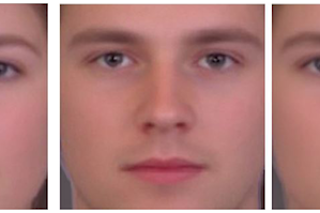Figure 1. The Prototypes.
People generally prefer mates that resemble themselves (except perhaps when they're stressed out). But how much of a resemblance is ideal? Too much, and you risk mating with a close relative, but not enough and maybe you end up mating with someone from a warring tribe. Here, the researchers photoshopped people's faces into those of their romantic partners, varying the amount of each face in the resulting blend. They then had the subject rate the attractiveness of each morphed face. They found that adding 22% of the subject's own face made their partner the most attractive (versus 11% and 33%). Not only that, but the subject didn't even realize that their partner's face had been morphed with their own. Apparently we're all just narcissists at heart.
Is beauty in the face of the beholder? "Opposing forces influence assortative mating so that one seeks a similar mate ...














